Restaurant style pathia curry is the perfect balance of hot, sweet and sour. It may not be a curry that comes to mind immediately but once you try it you will be hooked.
This is a curry you don’t see in all Indian restaurants. That’s because they all make the same 15 curries. Why is that?
Tell me I am wrong. It’s like they all got together and printed the same menu to save money. I know. I rant about that one a lot. But why can’t they break the formula?
India has one of the most varied cuisines in the world. How hard can it be to make something that isn’t a madras? Or a jalfrezi? Or butter chicken? Seriously.
Pathia is nowhere to be found where I live. There are lots of Indian restaurants. Lots. But no pathia. Which is a bit ridiculous. It’s tasty stuff. It would sell. If you’ve never tried it you really should.
Pathia curry is true evolutionary cooking
This is an old dish. Historic really. Pathia has it’s roots in an ancient Persian dish. It’s been adapted to Indian cooking and then again to Indian restaurant style cooking. And it made it big in the curry houses in the UK.
You don’t even see it much in Indian cookbooks. Or on the big curry websites from India. It’s fallen by the wayside. There are a few recipes out there but not many. The curry that time forgot.
It is real culinary Darwinism. It started when the Persians emigrated to India. They brought their cooking style and techniques. Like dhansak curry did.
They settled in Gujarat. And had to make do with the ingredients at hand. No amazon prime back then. So they evolved it to use Gujarati spices. Locavores.
It used to be that pathia was reserved for celebrations. Not every day dinner. When you taste it you will understand why.
And then it seems it fell from favour. From Indian wedding to dinner at a local take-out restaurant. That’s quite a fall from grace. No offence to restaurants intended.
But it’s worth trying. It’s good. Maybe you can be part of the great pathia revival. I am.
I love how food evolves through time. Centuries in this case. From Persia to India to the UK. And now to you.
Pathia has a distinctive flavour profile
It really doesn’t taste like any of the other famous curries. It’s hot. Medium spicy anyway. And sour. And sweet. Tamarind adds a nice zing.
Restaurant style pathia curry really isn’t your run of the mill curry. A bit different. But in a really good way.
Making it restaurant style gives it that characteristic restaurant gravy. All that good sauce to mix with rice. Or to dip your flat bread into.
It’s versatile as well. It works well with chicken, lamb, shellfish, paneer – anything really.
Do your prep before you get started
Make your curry base and have some heated and ready to go. Pre-cook your meat. Measure out your ingredients.
Have everything ready. Indian restaurant style cooking goes fast. Maybe 10 minutes from start to finish.
And please put on some old clothes. It’s messy cooking. Turmeric stains are impossible to get out. You will not be happy about it if you don’t. But a bit of splatter is part of the fun.
If you haven’t read the guide to Indian restaurant technique yet, do it now. It has pictures to help you understand the recipe and cooking method.
There’s also a guide to Indian ingredients in that post. That should help take the mystery out of this. Once you get it, you’ll be able to make all your favourite restaurant dishes.
Restaurant style pathia curry. It’s for when you want to try something new. Something special. Something delicious.
restaurant style pathia curry
Ingredients
The spice mix
- 2 tsp indian restaurant spice mix or curry powder - recipe link below
- 1 tsp hot madras curry powder - or use more Indian restaurant mix powder if you don't have any madras curry powder
- 2 tsp kashmiri chili powder or 1/2 tsp cayenne mixed with 1 1/2 tsp paprika
- 1/2 tsp kasoor methi - dried fenugreek leaves
- 1/2 tsp kosher salt
The curry ingredients
- 3 Tbsp oil
- 1 Tbsp garlic/ginger paste - recipe link below
- 1 Tbsp tomato paste with enough water to dilute to the consistency of pasatta
- 15 oz curry base - recipe link below
- 10-12 oz pre-cooked chicken or lamb
- 1 Tbsp tamarind sauce - not tamarind paste or concentrate. I like Maggi brand for this recipe.
- 1 tsp brown sugar
Instructions
- Make the spice mix.
- Dilute the tomato paste with enough water to get to the consistency of passata.
- Heat your frying pan (don't use non-stick) briefly over medium heat. Add the oil.
- When the oil starts to shimmer add the garlic ginger paste and cook, stirring constantly, until it stops sputtering.
- Turn down the heat and add the spice mix. This is the critical step. Stir it constantly for 30 seconds. If it starts to darken lift the pan off the heat. You want the spice mix to cook in the oil but not burn.
- Turn the heat up to medium high. This is important. The heat is what caramelizes the onion in the curry base and gives the curry it's Indian restaurant flavour. As you become more comfortable with this technique try pushing it. Add the diluted tomato paste and stir until bubbles form (the oil will likely separate). This takes around 30 seconds to one minute depending on the heat.
- Add 3 oz of curry base. Stir until bubbles form (little craters really), around 30 seconds. Think lively boil. Watch the edges of the pan. The curry can stick here. Sticking is OK. Just scrape it back into the base. Burning is bad.
- Now add 6 oz of curry base and stir briefly. Let it cook until the bubbles form again. This takes 1-2 minutes.
- Add the rest of the curry base and let cook until the bubbles form.
- Mix in the tamarind sauce and sugar.
- Turn the heat down to low and add the pre-cooked lamb, beef or chicken.
- Let the curry simmer for about 5 minutes. If it gets too thick add a bit more curry base. Don't add water.
- Garnish with a bit of chopped fresh cilantro and serve.
Notes
Nutrition
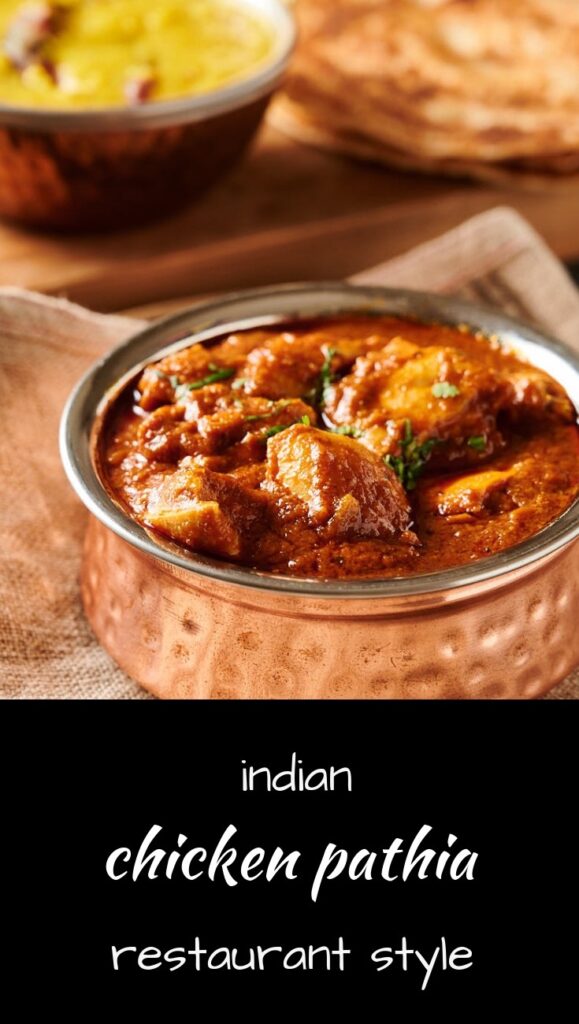

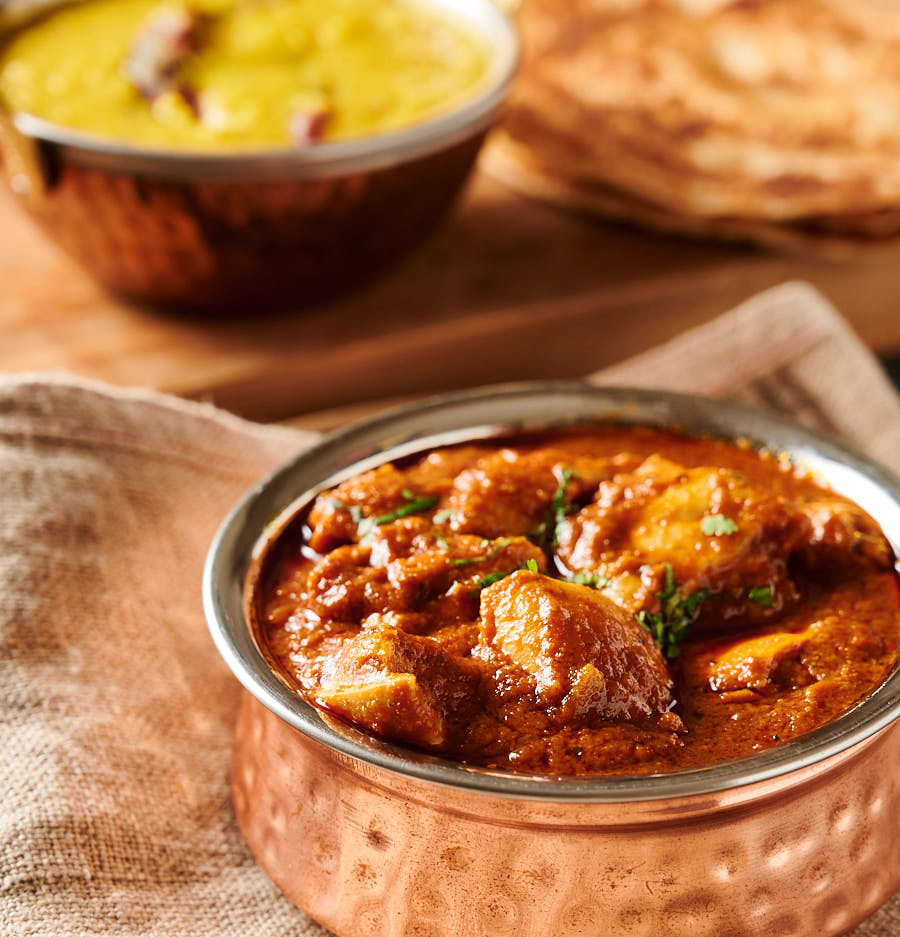
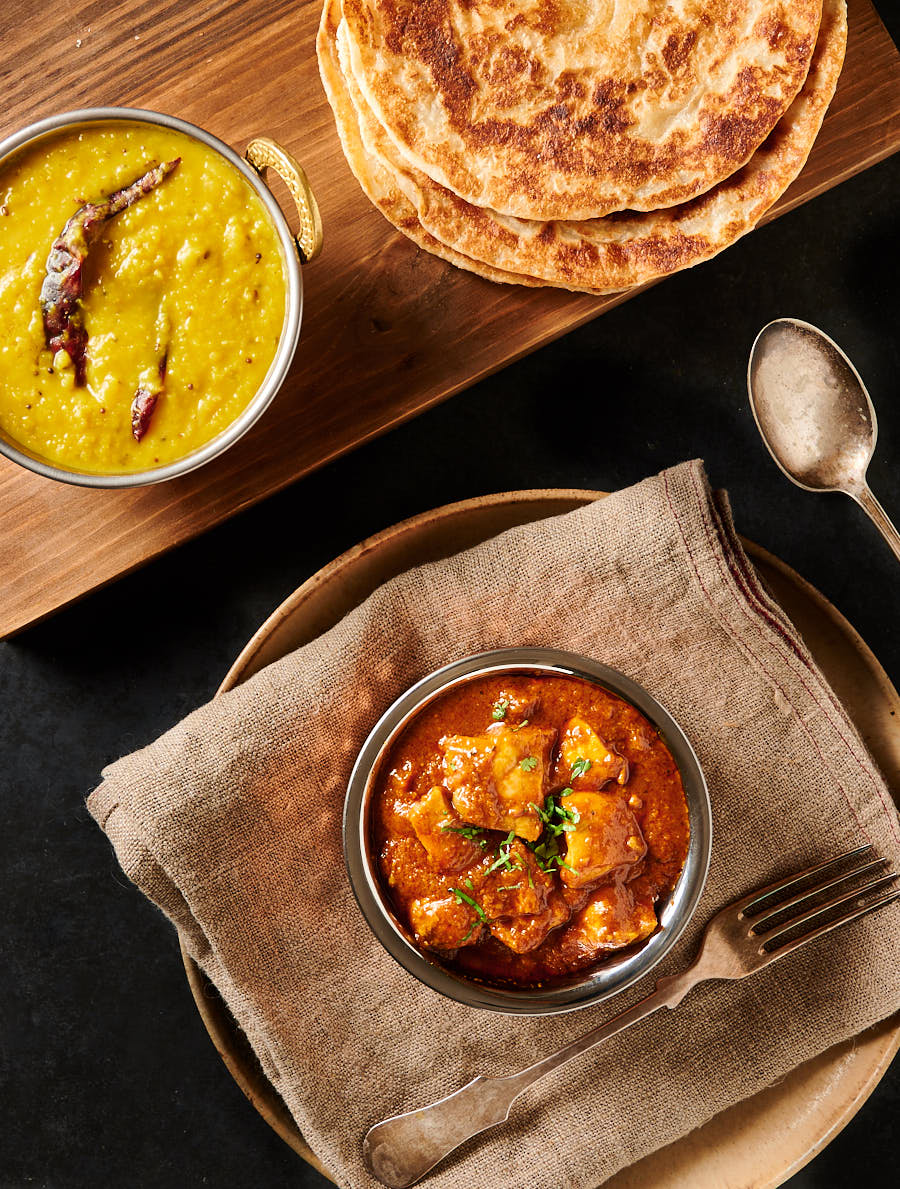
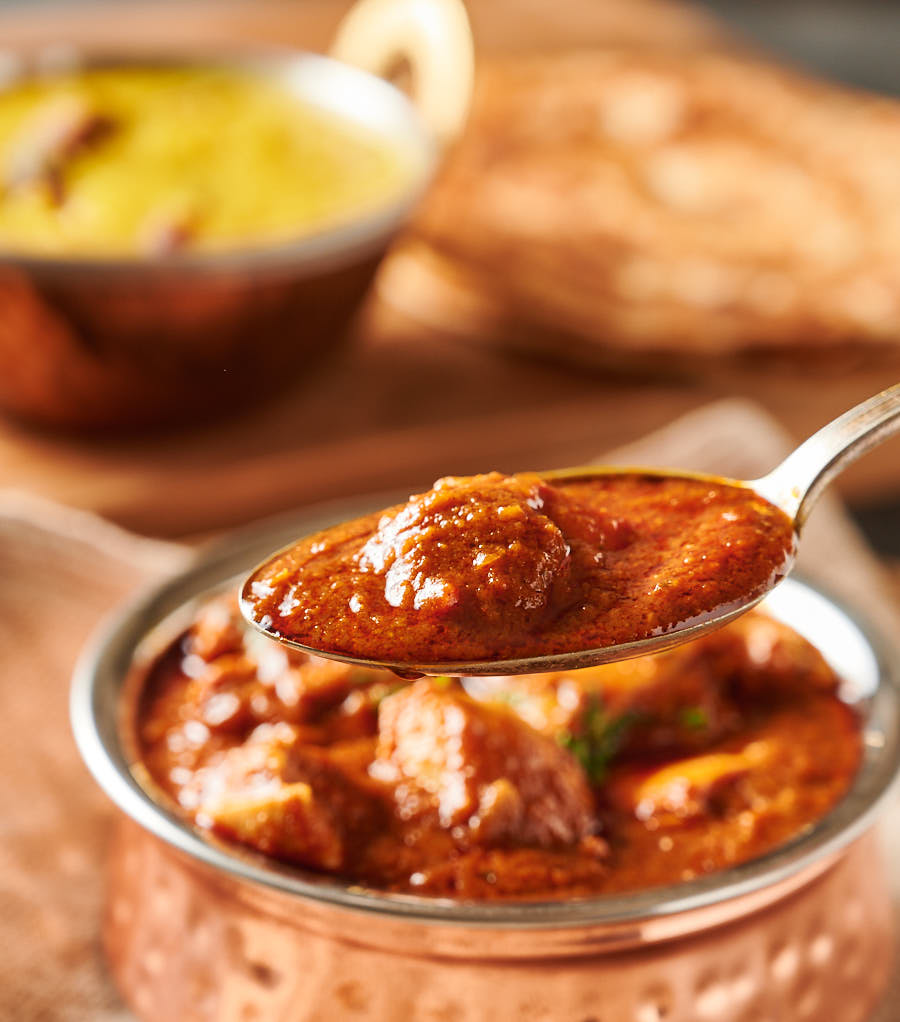
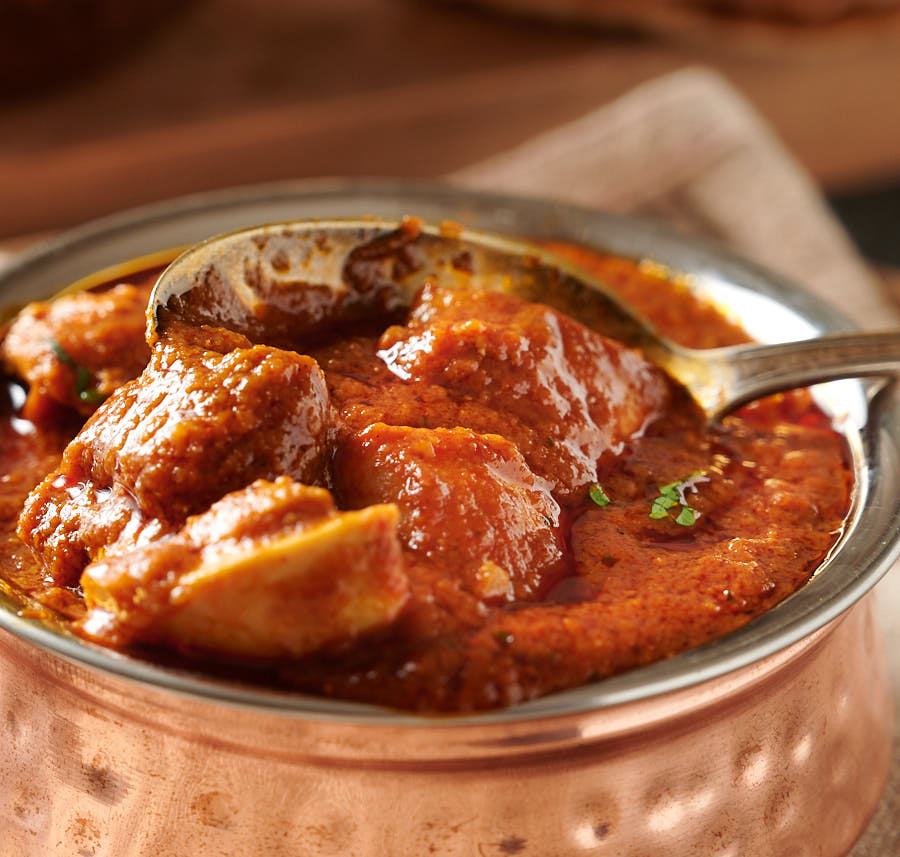
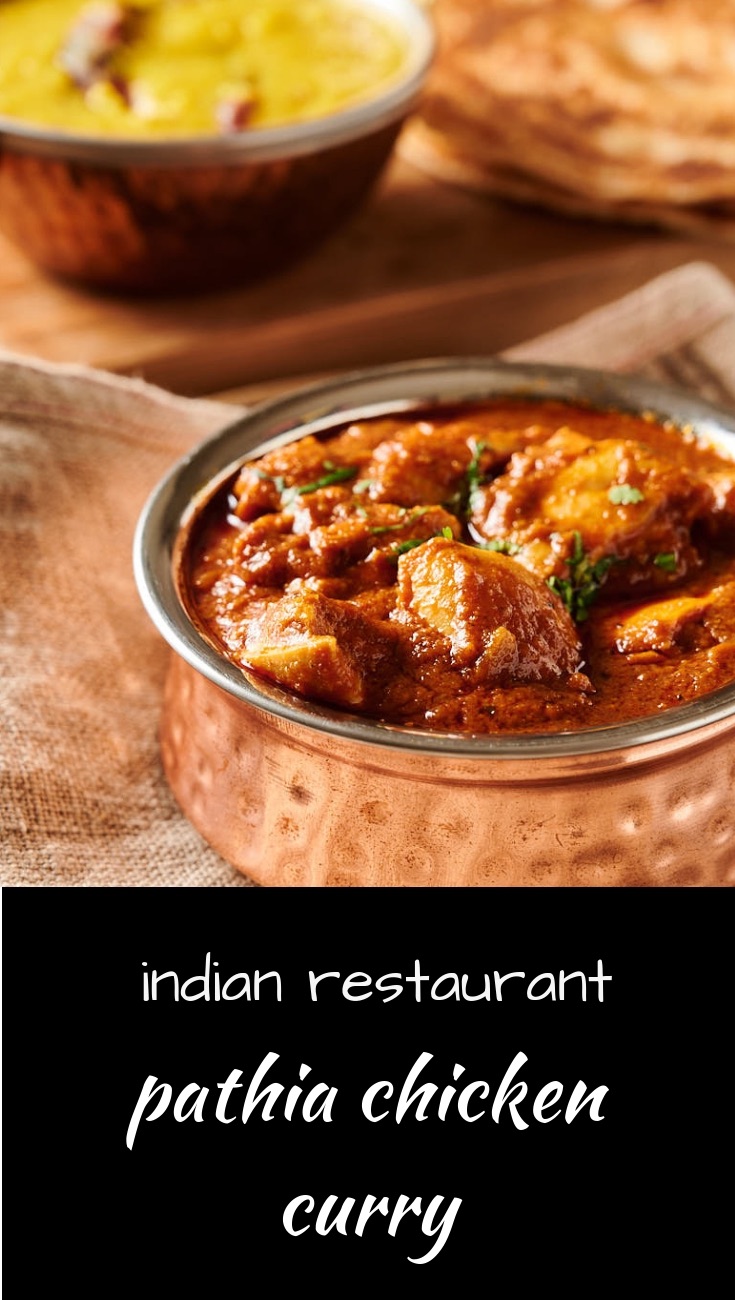
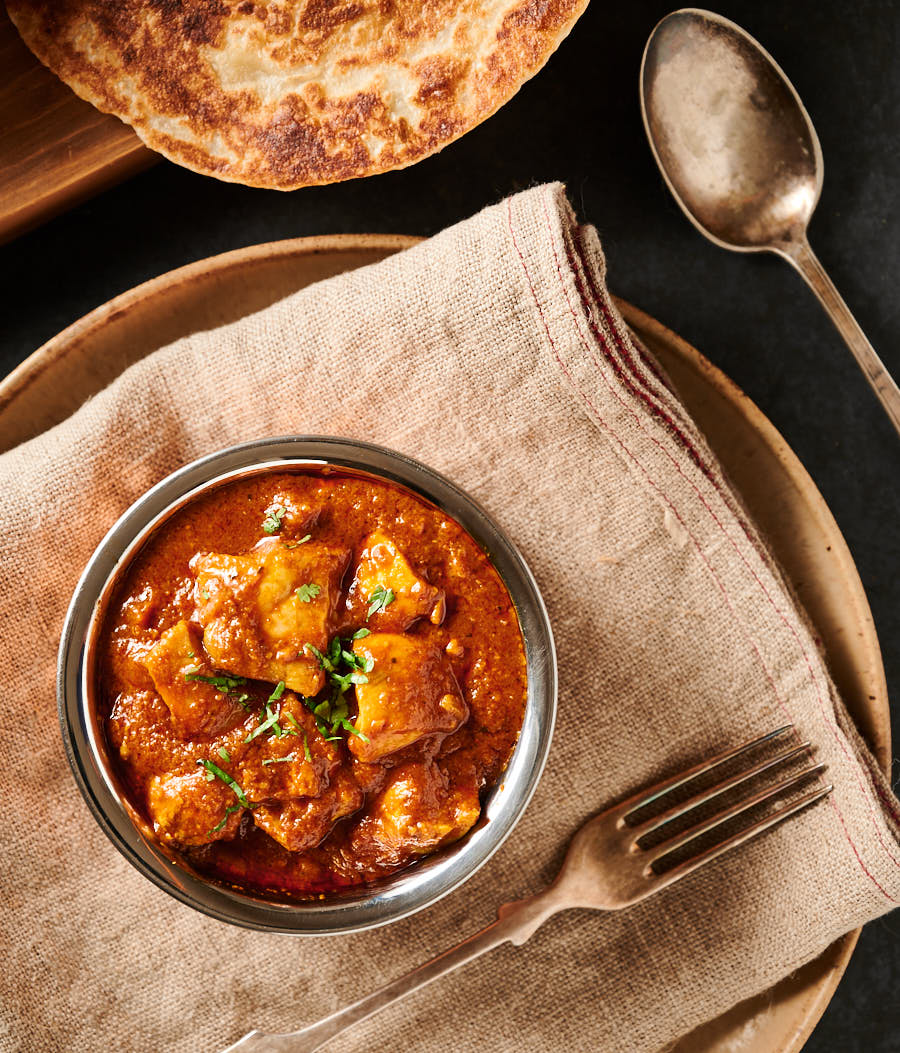
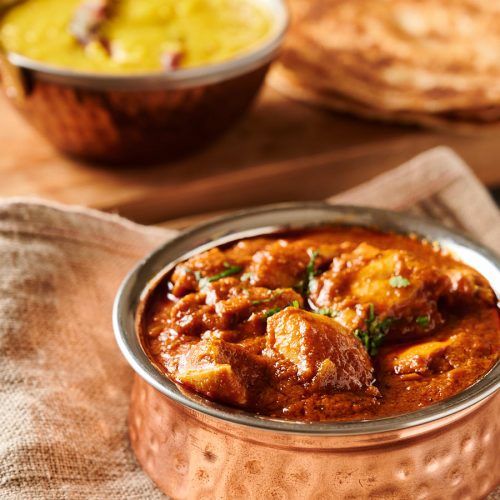
Good grief. I made the curry base and then used it with an authentic spice mix from my local Asian retailer (in this case it was Shan brand ‘Chili Chicken Masala’) for the frying part.
Absolutely first class. This is the closest to a British Bangladeshi curry I’ve ever managed.
Thank you.
Giles
Welcome to the rabbit hole. Indian restaurant style is addictive!
These recipes are incredible. I won’t be getting take away again. Thank you so much!
That’s great to hear!
I can’t wait to try this recipe. Sounds a bit like vindaloo with the sweet-sour thing happening. And like you, I find Indian restos (in the US) so frustrating! Happily, we have moved to a state that has two South Indian restaurants and I am close enough to have masala dosa delivered. So happy. Will need to break down and make your curry base. Thanks!
We have a few South Indian restaurants where I am. They are, by far, my favourite in town.
Pathia used to be one of my favourites from the local take away and this recipe is even better. Lots of spice but not too hot, sweet and sour. I added a bit more sugar to mine (I like a bit of extra sweetness to balance the sour)
I’m guilty of having virtually no sweet tooth. There isn’t a single desert on this blog and I’m at over 300 recipes to date. So I tend to prefer my curries perhaps a little less sweet than some. Glad to hear you tweaked it to your taste. I love it when people make these recipes their own!
My first recipe after finding Glebe Kitchen and I’m hooked! Love the processes involved in preparing this dish and the final curry is superb, well worth all the time but now the freezer is packed with curry base ready for the next recipe. Thank you for the great site and tips!
You’re very welcome. I’m delighted you are enjoying it.
Trying Keema Matar tonight I’ll post the verdict later!
Oh wow! Made this last week and it’s the best curry I’ve ever made! A new favourite in our house. Thanks for sharing this.
My pleasure. Glad you like it!
This is amazing. I’ve tried for so long to find out how to make restaurant style curries and I’ve finally found this website which has taught me how to do it. The Pathia is so good. Thank you!
You are very welcome. It took me forever to figure it out too. It is just not intuitive until you understand what tricks and techniques restaurants are using. You are on the inside now!
Hi Romain, sorry to ask on another person’s post but I couldn’t find how to make my own post. Just wanted to ask if I wanted to make the pathia to use up all the curry base is it as easy timesing the recipe by 6? Or would it require different mounts?
Many thanks
Claire
No problem. For restaurant style if you have a really big pan you can push it and go double if you are confident that you can drive your pan hard enough to get the curry base to really fry. For sure it would not work if you try to multiply it by six in one go I am afraid.
As all the other replies have gone .WOW what a flavour it actually tasted the same as a restaurant Pathia .superb thanks a lot romain will continue to try more recipes
I’m so glad you enjoyed the pathia. Looking forward to hearing how others go for you!
Thank you very much romain! Best curry I’ve ever cooked just like the restaurant! Just gotta perfect rice now instead of boil in the bag!!!
Great to hear! I guess I should post a rice recipe one of these days. Not that hard although these days I am loving rice my rice cooker. Perfect rice every single time easy to get used to.
Ah, do you mean the onions that have been blended into the curry base ? I’m guessing so….
Exactly right. The curry base is how restaurants skip the long browning of onions step used in traditional Indian cooking.
Hi, just made the curry base and spice mix and garlic and ginger paste, my question on this particular recipe is what onions ? You’re talking about browning them off but there are non in the recipe, excuse my noviceness lol and thanks.
Tried this as my first attempt at one of the restaurant-style recipes as it is one of my wife’s favourites; couldn’t be happier with how it turned out. I guess heating the base and adding it in stages is to keep the temperature in the pan high enough to quickly caramelise the onions? It seems to work anyway. Thanks a million – going to have to choose the next one to try now…
So glad you liked it! Caramelization of the onions is exactly why heating the base and adding it in stages is important. Please let me know how your next one works out.
It looks perfect and tasty! Can’t wait to have this anytime of the day, love it!
Romain,it’s awesome! I cannot wait to try this. I bet it makes the house smell divine and tastes incredible!
So glad you like it. Indian restaurant style adds a whole new way of making curry for the home cook.
Make this every week now. Excellent recipe. Thank you.
That’s great to hear!
Made this yesterday absolute winner can’t wait to try some of the other recepies.
Great to hear. I hope you find some more you like!
I’ve never tried a Pathia before,so I gave this one a go. What a result again! So far I have made your butter chicken and lamb saag using all the techniques you have very kindly taken time to supply. I even made my own tamarind paste for this.Excellent. Thanks so much. Next challenge chicken tikka masala.
Sounds like you are in the groove. Once you get the technique down it’s quite easy to whip up amazing curries. Keep going!
Absolutely superb. Really authentic Indian restaurant style curry. Vegetarian so used mushroom and potato. Delicious Can’t wait to try the other recipe soon, thank you Glebe Kitchen
You are very welcome. So glad you liked it. Mushroom and potato sounds delicious!
Spent two days making this – making the base, buying spices I didn’t have etc… and good lord, the result was bloody fantastic. Literally the best curry I’ve ever cooked at home. And I still have 5 pots of curry base and spice mix and garlic/ginger paste….
And now you can make just about any other restaurant curry!
Great recipe, thank you.
Glad you liked the pathia!